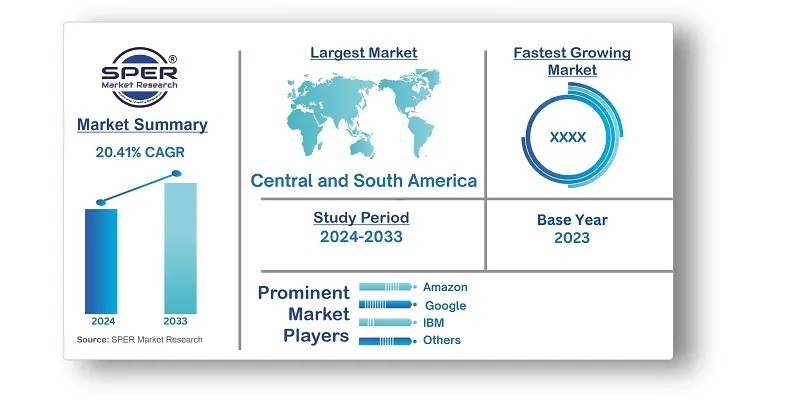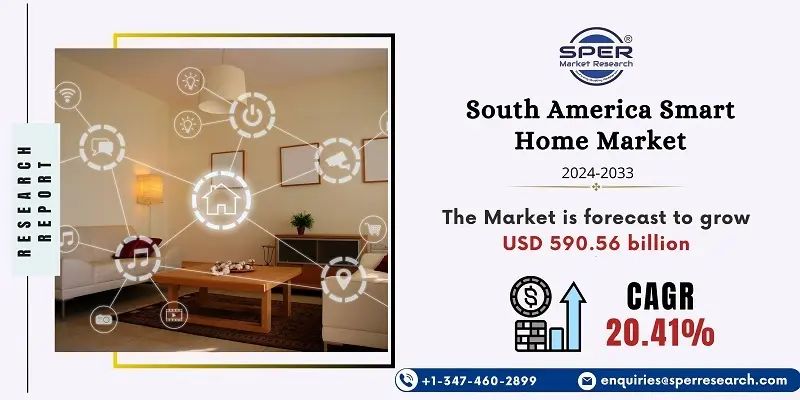
South America Smart Home Market Trends, Share, Demand, Competition and Future Outlook
South America Smart Home Market Growth, Size, Trends Analysis- By Device Type, By Housing Type- Regional Outlook, Competitive Strategies and Segment Forecast to 2033
| Published: Oct-2024 | Report ID: IACT24167 | Pages: 1 - 158 | Formats*: |
| Category : Information & Communications Technology | |||
- December 2023; TCL Electronics launched a video campaign with Team Brazil during the FIFA World Cup to promote its smart appliances, which include refrigerators, washing machines, and air conditioners. Their business operations in Brazil, Spain, England, and the rest of Europe were improved as a result.
- December 2022; Vivint Smart Home Inc., a provider of security systems and smart home platforms, was purchased by NRG Energy Inc. for USD 2.8 billion. The acquisition boosted the company's expansion plans and opened up new markets thanks to Vivint's technological know-how and strategic insights.


| Report Metric | Details |
| Market size available for years | 2020-2033 |
| Base year considered | 2023 |
| Forecast period | 2024-2033 |
| Segments covered | By Device Type, By Housing Type |
| Regions covered | South America, Brazil, Argentina, Rest of South America |
| Companies Covered | Amazon, Google, Honeywell, IBM, LG Electronics, Philips, Samsung, Schneider Electric, Siemens, and Whirlpool. |
- Homeowners
- Renters
- Tech-Savvy Consumers
- Families
- Young Professionals
- Seniors
- Real Estate Developers
- Small Business Owners
- Eco-Conscious Consumers
| By Device Type: | |
| By Housing Type: |
- South America Smart Home Market Size (FY’2024-FY’2033)
- Overview of South America Smart Home Market
- Segmentation of South America Smart Home Market By Device Type (Safety and Security Devices, Energy and Water Control, Climate Control, Lighting Control, Consumer Electronics, Others)
- Segmentation of South America Smart Home Market By Housing Type (Multifamily Dwelling, Single-family Dwelling)
- Statistical Snap of South America Smart Home Market
- Expansion Analysis of South America Smart Home Market
- Problems and Obstacles in South America Smart Home Market
- Competitive Landscape in the South America Smart Home Market
- Impact of COVID-19 and Demonetization on South America Smart Home Market
- Details on Current Investment in South America Smart Home Market
- Competitive Analysis of South America Smart Home Market
- Prominent Players in the South America Smart Home Market
- SWOT Analysis of South America Smart Home Market
- South America Smart Home Market Future Outlook and Projections (FY’2024-FY’2033)
- Recommendations from Analyst
1.1. Scope of the report1.2. Market segment analysis
2.1. Research data source2.1.1. Secondary Data2.1.2. Primary Data2.1.3. SPER’s internal database2.1.4. Premium insight from KOL’s2.2. Market size estimation2.2.1. Top-down and Bottom-up approach2.3. Data triangulation
4.1. Driver, Restraint, Opportunity and Challenges analysis4.1.1. Drivers4.1.2. Restraints4.1.3. Opportunities4.1.4. Challenges4.2. COVID-19 Impacts of the South America Smart Home Market.
5.1. SWOT Analysis5.1.1. Strengths5.1.2. Weaknesses5.1.3. Opportunities5.1.4. Threats5.2. PESTEL Analysis5.2.1. Political Landscape5.2.2. Economic Landscape5.2.3. Social Landscape5.2.4. Technological Landscape5.2.5. Environmental Landscape5.2.6. Legal Landscape5.3. PORTER’s Five Forces5.3.1. Bargaining power of suppliers5.3.2. Bargaining power of buyers5.3.3. Threat of Substitute5.3.4. Threat of new entrant5.3.5. Competitive rivalry5.4. Heat Map Analysis
6.1. South America Smart Home Market Manufacturing Base Distribution, Sales Area, Product Type6.2. Mergers & Acquisitions, Partnerships, Product Launch, and Collaboration in South America Smart Home Market
7.1. South America Smart Home Market Size, Share and Forecast, By Device Type, 2020-20267.2. South America Smart Home Market Size, Share and Forecast, By Device Type, 2027-20337.3. Safety and Security Devices7.4. Energy and Water Control7.5. Climate Control7.6. Lighting Control7.7. Consumer Electronics7.8. Others
8.1. South America Smart Home Market Size, Share and Forecast, By Housing Type, 2020-20268.2. South America Smart Home Market Size, Share and Forecast, By Housing Type, 2027-20338.3. Multifamily Dwelling8.4. Single-family Dwelling
9.1. South America Smart Home Market Size and Market Share
10.1. South America Smart Home Market Size and Market Share By Region (2020-2026)10.2. South America Smart Home Market Size and Market Share By Region (2027-2033)10.3. South America10.3.1. Argentina10.3.2. Brazil10.3.3. Rest of Latin America
11.1. Amazon11.1.1. Company details11.1.2. Financial outlook11.1.3. Product summary11.1.4. Recent developments11.2. Google11.2.1. Company details11.2.2. Financial outlook11.2.3. Product summary11.2.4. Recent developments11.3. IBM11.3.1. Company details11.3.2. Financial outlook11.3.3. Product summary11.3.4. Recent developments11.4. LG Electronics11.4.1. Company details11.4.2. Financial outlook11.4.3. Product summary11.4.4. Recent developments11.5. Philips11.5.1. Company details11.5.2. Financial outlook11.5.3. Product summary11.5.4. Recent developments11.6. Samsung11.6.1. Company details11.6.2. Financial outlook11.6.3. Product summary11.6.4. Recent developments11.7. Schneider Electric11.7.1. Company details11.7.2. Financial outlook11.7.3. Product summary11.7.4. Recent developments11.8. Siemens11.8.1. Company details11.8.2. Financial outlook11.8.3. Product summary11.8.4. Recent developments11.9. Honeywell11.9.1. Company details11.9.2. Financial outlook11.9.3. Product summary11.9.4. Recent developments11.10. Others
SPER Market Research’s methodology uses great emphasis on primary research to ensure that the market intelligence insights are up to date, reliable and accurate. Primary interviews are done with players involved in each phase of a supply chain to analyze the market forecasting. The secondary research method is used to help you fully understand how the future markets and the spending patterns look likes.
The report is based on in-depth qualitative and quantitative analysis of the Product Market. The quantitative analysis involves the application of various projection and sampling techniques. The qualitative analysis involves primary interviews, surveys, and vendor briefings. The data gathered as a result of these processes are validated through experts opinion. Our research methodology entails an ideal mixture of primary and secondary initiatives.



Frequently Asked Questions About This Report
PLACE AN ORDER
Year End Discount
Sample Report
Pre-Purchase Inquiry
NEED CUSTOMIZATION?
Request CustomizationCALL OR EMAIL US
100% Secure Payment






Related Reports
Our Global Clients
Our data-driven insights have influenced the strategy of 200+ reputed companies across the globe.




















